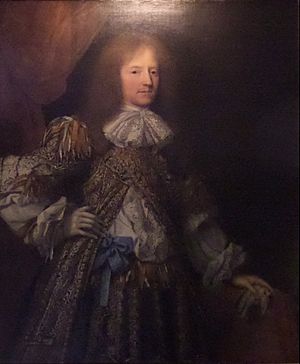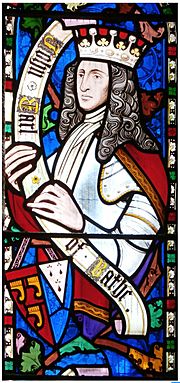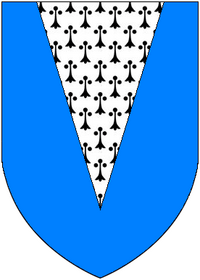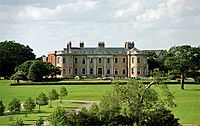John Granville, 1st Earl of Bath facts for kids
Quick facts for kids
John Granville, 1st Earl of Bath
|
|
|---|---|

John Granville, 1st Earl of Bath
|
|
| Lord Lieutenant of Devon | |
| In office December 1685 – April 1696 |
|
| Lord Warden of the Stannaries | |
| In office October 1660 – August 1701 |
|
| Lord Lieutenant of Cornwall | |
| In office October 1660 – May 1696 |
|
| Governor of the Scilly Isles | |
| In office 1649–1651 |
|
| Personal details | |
| Born |
John Grenville
29 August 1628 Kilkhampton, Cornwall |
| Died | 22 August 1701 (aged 72) St James's, London |
| Resting place | St James' church, Kilkhampton |
| Nationality | English |
| Spouse | Jane Wyche (1652–1692) |
| Children | Jane (c. 1653 – 1696); Charles (1661–1701); John (1665–1707); Catherine (1666–?); Grace (1667–1744) |
| Parents | Sir Bevil Grenville (father); Grace Smythe (mother) |
| Occupation | Soldier, landowner and courtier |
| Military service | |
| Rank | Colonel |
| Battles/wars | Wars of the Three Kingdoms Lostwithiel; Second Newbury; Torrington; |
John Granville, 1st Earl of Bath PC (29 August 1628 – 22 August 1701) was an English landowner who served in the Royalist army during the First English Civil War and was rewarded for his services after the 1660 Stuart Restoration with a title and various appointments.
Personal details
John was born on 29 August 1628 at Kilkhampton in Cornwall, the third son of Sir Bevil Grenville (1596–1643) and Grace Smythe (died 1647). His aunt Elizabeth Smythe was the mother of George Monck who played a leading role in the 1660 Stuart Restoration and it was this connection that later resulted in Grenville being raised to the peerage as Earl of Bath.
One of thirteen children, John's two elder brothers died prematurely, making him heir to his father's considerable estates when Sir Bevil was killed at the Battle of Lansdowne in 1643.
Career
During the 1638 to 1651 Wars of the Three Kingdoms, Granville fought in the regiment raised by his father for Charles I (1625–1649). Created a knight after the Storming of Bristol in 1643, he was appointed Gentleman of the Bedchamber to the future Charles II and accompanied him into exile. When the Second English Civil War began in 1648, Charles appointed him Governor of the Scilly Isles, which had rebelled against its Parliamentary garrison. As a base for Royalist privateers attacking English and Dutch vessels in the Western Approaches, this was a vital source of funding for the exiled Court; in May 1651, Parliamentary forces under Robert Blake retook the islands and Granville was captured.
On his release, Granville remained in England and continued to be active in Royalist conspiracies. In 1660, he served as an intermediary in the negotiations between Charles and his distant relative George Monck that led to the Restoration. To his disappointment, the Dukedom of Albemarle went to Monck, whom Charles also rewarded with the then-enormous pension of £7,000 per year. Instead, he was created Baron Granville, Viscount Granville and Earl of Bath in 1661, and a Privy Councillor in 1663.
In 1665, he was appointed Lord Lieutenant of Ireland, although he never went there and spent large sums of time and money on rebuilding the family home of Stowe House in Cornwall. Widely admired, it was dismantled in 1739, although many of its ornamental features, including entire rooms, can be seen at the Guildhall in South Molton, Devon. Albemarle also expanded his own ancestral seat of Potheridge, about 18 miles to the east; unfinished on his death, it was badly damaged by fire and demolished in 1734.
Granville was a signatory to The Several Declarations of The Company of Royal Adventurers of England Trading into Africa, a document published in 1667 which led to the creation of the Royal Africa Company. This is speculated to have been influenced by the fact that Granville was close friends with the Royal African Company's leader, the Duke of York (and future King James II), who was brother to Charles II.
Under James II, Granville served as colonel of the Earl of Bath's Regiment, later 10th Foot, first during the June 1685 Monmouth Rebellion and again in 1688. During the November 1688 Glorious Revolution, he commanded the key ports of Exeter and Plymouth but defected to William III on 18 November.
He was rewarded by being made Lord Lieutenant of Devon but again failed to gain the title of Albemarle and the legal dispute over the Albemarle estate almost bankrupted him. Two weeks after his death in August 1701, his son Charles died.
Marriage and progeny
In October 1652 at Kilkhampton John Granville married Jane Wyche, a daughter of Sir Peter Wyche, English ambassador to the Ottoman Empire. By his wife, he had five children:
Sons
- Charles Granville, 2nd Earl of Bath (1661-1701), eldest son and heir. He died during the preparations for his father's funeral. He was twice married, firstly to Lady Martha Osborne, daughter of Thomas Osborne, 1st Duke of Leeds (d. 11 September 1689, aged 25), and secondly, on 10 March 1691, to Isabella van Nassau (bapt. 20 April 1668, d. in childbirth on 30 January 1692 at London), sister of Henry Nassau d'Auverquerque, 1st Earl of Grantham. He had no children by his first wife, but by his second wife was the father of:
- William Henry Granville, 3rd Earl of Bath (30 January 1692 – 1711) who died of smallpox aged 19 without progeny when the earldom became extinct.
- John Granville, 1st Baron Granville of Potheridge (1665–1707). Potheridge in Devon was the ancient seat of the Monck family, where the 1st Earl of Bath's cousin, close friend and collaborator in the Restoration of the Monarchy, George Monck, 1st Duke of Albemarle (1608–1670) had built a grand mansion. It was settled on the 1st Earl of Bath by the Duke's childless son Christopher Monck, 2nd Duke of Albemarle (1653–1688), and eventually passed to the Leveson-Gower family (see below).
Daughters
- Lady Jane Granville (d. 27 February 1696), wife of Sir William Leveson-Gower, 4th Baronet and mother of John Leveson-Gower, 1st Baron Gower. The progeny of this marriage were co-heirs to the 3rd Earl of Bath. Her great-grandson was Granville Leveson-Gower, 1st Marquess of Stafford (1721–1803) one of whose younger sons was Granville Leveson-Gower, 1st Earl Granville (1773–1846).
- Lady Catherine Granville, wife of Craven Peyton, Member of Parliament for Boroughbridge 1705–1713. Without progeny.
- Lady Grace Granville, suo jure 1st Countess Granville (3 September 1654 – 18 October 1744), wife of George Carteret, 1st Baron Carteret of Haynes Park, Bedfordshire, and mother of John Carteret, 2nd Baron Carteret, 2nd Earl Granville. The progeny of this marriage, Barons Carteret, Earls Granville, and Marquesses of Bath (Thynne), were co-heirs to the 3rd Earl of Bath.
Death
He died in London in 1701, one week before his 73rd birthday.
Armorials

The armorials of the family of Granville / Grenville of Glamorgan, Devon and Cornwall are of certain form but uncertain blazon. The charges appear in the form of musical pipes of a wind instrument, similar to pan-pipes. Authoritative sources on heraldry suggest the charges to be variously "clarions" (used by Guillim (d. 1621)), the most usual blazon, which are, however, generally defined as a form of trumpet; "rests" is another common blazon, denoting lance-rests supposedly used by a mounted knight; "organ-rests" is also met with, a seemingly meaningless term (Gibbon (1682)). Other terms are "clavicymbal", "clarichord" and "sufflue" (used by Leigh in his Armory of 1562 and by Boswell, 1572), the latter being a device for blowing (French: souffler) air into an organ. Guillim suggested the charge may be a rudder, but in which case it is shown upside down, when compared to that charge used for example on the tomb at Callington of Robert Willoughby, 1st Baron Willoughby de Broke. Certainly in the brasses on the chest tomb of Sir John Bassett (d. 1529) in Atherington Church, Devon, the charges are engraved in tubular forms with vents or reeds as used in true organ pipes.
Sources
| Military offices | ||
|---|---|---|
| Preceded by Sir William Morice |
Governor of Plymouth 1661–1696 |
Succeeded by Charles Trelawny |
| Preceded by The Lord Arundell of Trerice |
Governor of Pendennis Castle 1680–1696 |
Succeeded by Sir Bevil Granville |
| New regiment | Colonel of The Earl of Bath's Regiment 1685–1688 |
Succeeded by Sir Charles Carney |
| Preceded by Sir Charles Carney |
Colonel of The Earl of Bath's Regiment 1688–1693 |
Succeeded by Sir Bevil Granville |
| Court offices | ||
| English Interregnum | Lord Warden of the Stannaries 1660–1701 |
Succeeded by The 2nd Earl of Radnor |
| Honorary titles | ||
| English Interregnum | Lord Lieutenant of Cornwall 1660–1696 With: Viscount Granville 1691–1693 |
Succeeded by The 2nd Earl of Radnor |
| Preceded by The 1st Earl of Radnor |
Custos Rotulorum of Cornwall 1685–1696 |
|
| Preceded by The 1st Duke of Albemarle |
Lord Lieutenant and Custos Rotulorum of Devon 1670–1675 |
Succeeded by The 2nd Duke of Albemarle |
| Preceded by The 2nd Duke of Albemarle |
Lord Lieutenant of Devon 1685–1696 With: Viscount Granville 1691–1693 |
Succeeded by The Earl of Stamford |
| Custos Rotulorum of Devon 1689–1696 |
||
| Peerage of England | ||
| New creation | Earl of Bath 1660–1701 |
Succeeded by Charles Granville |
| Baron Granville (descended by acceleration) 1660–1689 |
||





